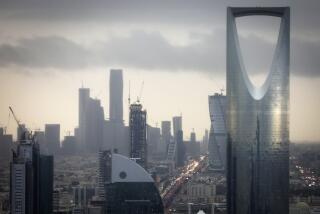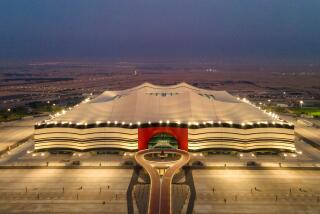Pakistan leader’s mangrove-to-metropolis dream
- Share via
SHAH BANDAR, Pakistan — In his dreams, Pakistani President Asif Ali Zardari sees a spectacular metropolis rising up from the vast stretches of mangrove swamp and sea-salted wasteland along the mighty Indus River Delta.
High-speed rail zips people from place to place. Vacationers soak up the South Asian sun at seaside resorts. Universities, factories and a new seaport pump vitality into the region. Miles of bike lanes crisscross the city, whose population would eventually reach 10 million.
Zardari wants to call his jewel Zulfikarabad, after Zulfikar Ali Bhutto, the founder of the country’s ruling party, a prime minister and president, and the father of Zardari’s slain wife, former premier Benazir Bhutto.
That’s a lot of dreaming for a country struggling with a dizzying array of afflictions: Millions of Pakistanis are dirt poor, struggling to find clean water, contending with unreliable electricity and living in fear of violent extremists. In addition, the president has continued jousting with Pakistan’s Supreme Court over long-standing graft allegations lodged years ago by Swiss authorities.
Such realities have put Zardari’s popularity in a tailspin.
Many observers suspect that the president’s enthusiasm for Zulfikarabad may be rooted in a burning desire to leave a legacy for this country of 180 million people. He’s seeking an enduring achievement, they say, by an administration widely viewed as rife with failure.
Government officials won’t place a price tag on the president’s lofty vision, which is bound to cost tens of millions of dollars. They say only that the government’s share would be limited to the construction of roads, bridges and other infrastructure, with the rest shouldered by investors.
Officials also say they consider the proposed city a desperately needed engine for jobs and economic growth.
Karachi, the country’s largest city with a population of 18 million, is bloated with overcrowding and traffic jams, and needs a nearby city that can serve as a relief valve, they say.
“Karachi is getting choked,” said Iftikhar Hussain Shah, managing director of the Zulfikarabad Development Authority. “It’s going to suffer paralysis because there’s no more room. So the people who are trying to look for setting up industries, they are looking for space.
“You give opportunity to entrepreneurs, you lay down the infrastructure, you have a good clean administration and clear-cut laws, and people will come,” Shah said. “People will come if they see there is a good opportunity to make money.”
Officials said building on tidal flats along the Arabian Sea coastline would also help combat a burgeoning problem: the encroachment of the sea at a rate of 18 acres a day.
The goal makes sense, but the strategy remains a bit fuzzy. A splashy brochure touting the project suggests that a sea wall 100 feet high could keep Zulfikarabad dry. Even Shah, however, wonders whether building a sea wall in an area routinely flooded by monsoons will work.
“If you build a wall, what will happen to all that [flood] water?” Shah said. “Maybe we’ll go to [other] countries for that expertise.”
For inspiration, Zulfikarabad proponents look to Shenzhen, a city of 10 million in China’s Pearl River Delta region. Once a small fishing village, Shenzhen’s transformation began in the early 1980s after Chinese leader Deng Xiaoping designated it as one of that country’s special economic zones, a status that seeded growth through tax exemptions and other measures aimed at attracting foreign investors.
Today, Shenzhen is hailed as one of the world’s fastest growing cities, an economic powerhouse with its own stock exchange, a bustling port, and a gleaming glass-and-steel skyline.
“Within a span of four years, it went from a fishermen’s town to earning $2 billion a year,” said Shah, who along with other Pakistani officials has toured Shenzhen. “In another 10 years, they were earning $150 billion a year.”
Critics say Pakistan’s reliance on Shenzhen as a template is misguided because China is an economic juggernaut with a gross domestic product 23 times the size of Pakistan’s. The impoverished Indus Delta isn’t likely to have the same pull as Shenzhen, and, sure enough, no Pakistani magnate has committed to making the Zulfikarabad dream a reality.
Officials expect Chinese companies to play a crucial, if not dominant, role in Zulfikarabad. They said one Chinese firm, Sichuan Huantong Holding Investment, signed a nonbinding memorandum of understanding with Pakistan this summer to help develop the city. Investors from the Czech Republic, Turkey and even Pakistan’s nuclear-armed archrival, India, also showed preliminary interest by talking with Pakistani officials about the possibility of building wind-power farms in Zulfikarabad, said Mumtaz Ali, planning director at the Zulfikarabad Development Authority.
Skeptics who doubt Zulfikarabad’s prospects cite Pakistan’s troubled record with another urban planning mega-project, the port city of Gwadar in the volatile province of Baluchistan.
Nearly a decade ago, Pakistan enlisted China’s help in transforming Gwadar into a major deep sea port on the Arabian Sea. Since then, Gwadar has been largely dormant, with cranes along piers rusting from inactivity. Opposition by Baluch nationalists, who worry that the Baluch people would be marginalized by Gwadar’s evolution into a modern city, has played a role in the project’s stagnancy, as has the dearth of roads and rail lines connecting the port to the rest of Pakistan.
Nusrat Javed, a columnist and talk show host for Pakistan’s Aaj TV, said the Zulfikarabad project “reminds all of us of Gwadar.”
“When Gwadar was being developed, the Baloch nationalists and the local population thought that, even though Pakistan and China were investing $248 million there was no possibility or promise of any kind of economic uplift for the Baluch community,” Javed said.
“Our president is extremely excited about [Zulfikarabad]. But to my mind, it seems more like a pipe dream.”
Many of those opposing the Zulfikarabad idea are nationalist parties and movements championing the cause of Sindhis, the indigenous population of Sindh province. Sindhi nationalist leaders acknowledge that if Zulfikarabad produces what it promises many local Sindhis will prosper. But they worry that a healthy, vibrant Zulfikarabad would attract hundreds of thousands of migrants from other parts of Pakistan, turning Sindhis into a distinct minority in their own land.
“After Pakistan came into being, the population of Karachi was 400,000,” said Jalal Mehmood Shah, leader of the Sindh United Party, a Sindhi political movement. “Then migrants came into Karachi and we, local Sindhis, became the minority. So we don’t want another place where we will become a minority. And we don’t want another situation where we aren’t allowed to take part in the development.”
On a recent afternoon in Shah Bandar, a fishing village not far from where ground was broken this summer for a $39-million Zulfikarabad bridge, a group of sweat-soaked fishermen thumbed through a brochure promoting the city. They weren’t too ruffled because they remembered a similar idea laid out by Bhutto’s administration years ago to turn a nearby fishing hamlet, Keti Bandar, into a major sea port.
“Bhutto said it would happen,” said Wali Mohammed, a 30-year-old Shah Bandar fisherman, “but years passed and nothing was built.”
More to Read
Sign up for Essential California
The most important California stories and recommendations in your inbox every morning.
You may occasionally receive promotional content from the Los Angeles Times.










